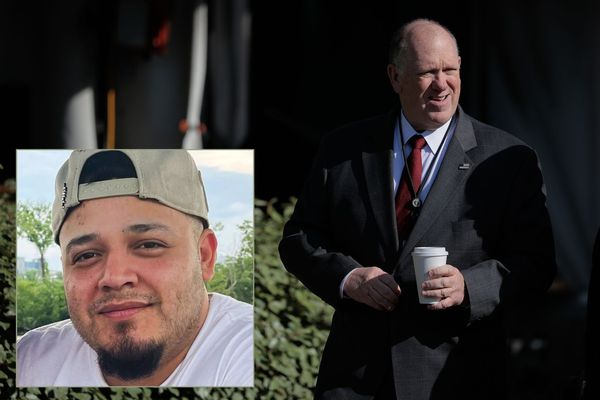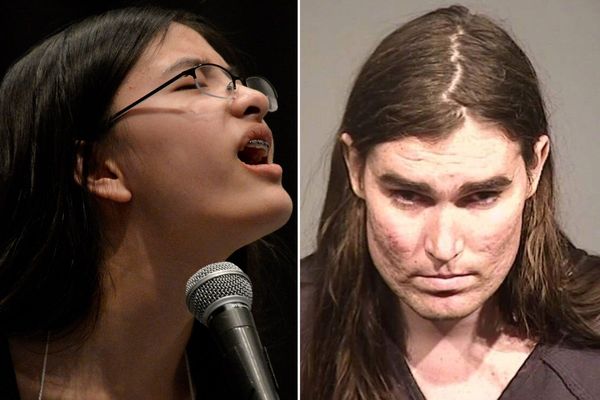“Are you the guy I follow on Instagram and TikTok?”
Remington Robinson often hears this while he is working on one of his en plein air miniature paintings.
That “in the open air” style of painting was popularized by French Impressionists like Claude Monet and Pierre-Auguste Renoir. But while their paintings cover large walls in expansive museums, Robinson’s canvases are limited to the small space on the inside of Altoids tins. Each measures 1 7/8 inches by 3 1/8 inches, to be exact.
Robinson’s small world is a wonder to behold. He uses tiny brushes to get fine detail in the minuscule frames, cutting panels of wood to fit precisely inside the top of the tin, which serves as the canvas. The base of the tin is his palette, where he chooses his colors; the palette remains in the box as part of the finished work.
In 2019, Robinson had about 10,000 followers on Instagram. Now he has more than 300,000. His TikTok videos, in which he explains his artistic process and creates time lapses of the works in progress, get millions of views.
The inspiration for Robinson’s tins, which sell for $350 apiece, is the natural beauty of Colorado. Here’s what else he had to say about his art. (Responses have been edited for clarity or for the sake of brevity.)
Q: How would you describe your art?
A: My paintings can be put into the category of realism as well as impressionistic realism. The work I am primarily known for is my mini plein air paintings in mint tins, although I have also worked on around 100 murals in the greater Denver region and beyond. For those not familiar with plein air, that means painting out in open air, usually outdoors, and referencing something that physically exists as opposed to painting from a photograph or from imagination.
Q. Briefly explain your process.
A: If we are talking about mint tin paintings, my process begins by setting up an empty tin with a panel and a palette of oil paint, and then going out somewhere to paint. Sometimes I have an objective and sometimes I don’t, and that keeps it interesting.
Q. What’s your background? Do you have any formal training?
A: I have some formal training, but most of the knowledge I rely on for my painting abilities is either from my high school art teacher David King, or from things I picked up along the way on my own after college. That being said, even though at times I wasn’t the best student, I did learn a lot in college, and graduated in 2010 with a BFA from Rocky Mountain College of Art + Design in Lakewood.
One particularly useful class I took there was a plein air painting class with Barry Kooser, who used to do background paintings for Disney movies.
I also had supportive and encouraging parents and grandparents. I’ve probably learned the most from observing nature, since I spent a lot of time outdoors when I was younger. I am constantly deriving inspiration from elements of other artists’ work, trying to back-engineer other paintings I’ve seen as well as trying to back-engineer nature into paint.
Q. Do you remember the first piece of art you ever got paid for?
A: A painting of sun rays emanating from behind a cloud. I did it in high school, and the school bought it for $75.
Q: Where can we see your art?
A: The best place is on my Instagram page: @RemingtonRobinson. I have a studio in Boulder where people can come visit by appointment. Since I don’t work there regularly, it’s best to send me a message on Instagram.
Q: What is the price range (or average price) for your works?
A: My mint tin work goes for $350 apiece.
Q. Do you have a favorite art piece? Perhaps one that isn’t yours?
A: Of my own, it is definitely a 32-by-48-inch acrylic painting from 2006 depicting a waterslide, a sailboat and an island just after sunset on Upper Saranac Lake in the Adirondacks in upstate New York. It is a view off of the main dock at my family’s vacation spot. My two favorite artists are Claude Monet and James Gurney. I find myself continually inspired by different aspects of pieces from both of them.
Q: What memorable responses have you had to your work?
A: One time, I was painting in Boulder and a guy walked by on his way somewhere and told me he had seen my work before and was a fan. He mentioned that he only knew of me because his mom followed me on Instagram, and that it was because of my work that she decided to get back into painting after 20 years of not doing it. That was really inspiring.
Q: What’s the best piece of advice you’ve ever been given?
A: To find a niche. Find something that you can do well that separates you from other artists. The more specific, the better. And if you do good work, there is always someone out there who will be willing to pay you money for it.
Q. What is essential to your art?
A: That I am painting something of my own choosing that brings me joy. That keeps it sustainable so that I can continue on without getting burned out. There have been several times when I was working on something that someone else wanted me to do, where it was like pulling teeth to try to get motivated. When I’m working on anything, it usually ends up being rather fun in some way, but starting is the hardest part with things you don’t want to do.
Q. What advice would you offer to beginning artists?
A: Try out different types of art. Pottery, woodworking, painting, drawing, sculpting out of various materials such as metal or stone, photography, quilting, etc. What you initially thought you would enjoy might not be what you would have expected. It is entirely possible to be initially bad at something and learn the skill to become really good. It just takes patience, practice and knowledge.
Q. Describe your dream project.
A: I don’t want to share my dream project because if I do, I am afraid that someone else would take it from me and do it before me!







